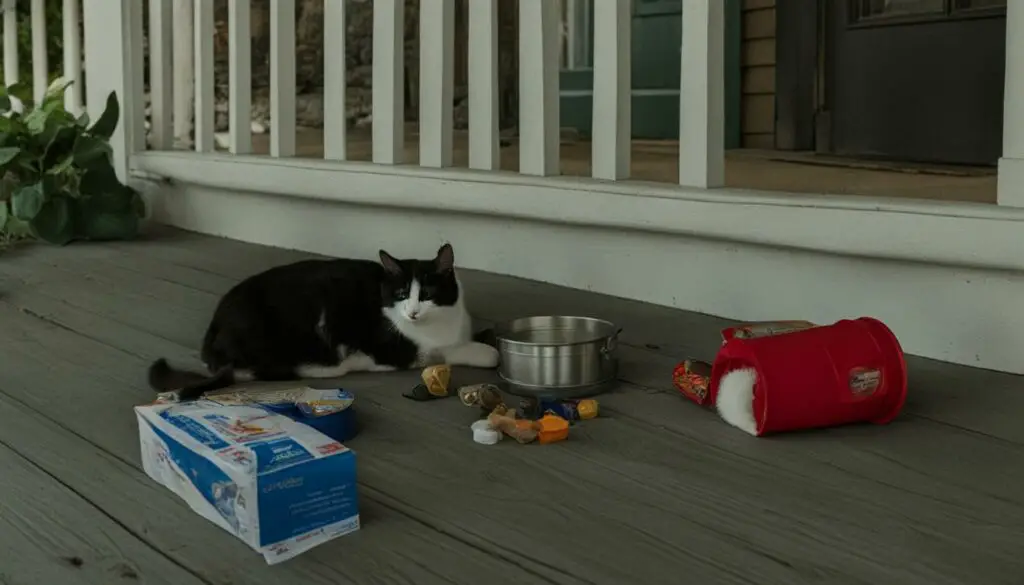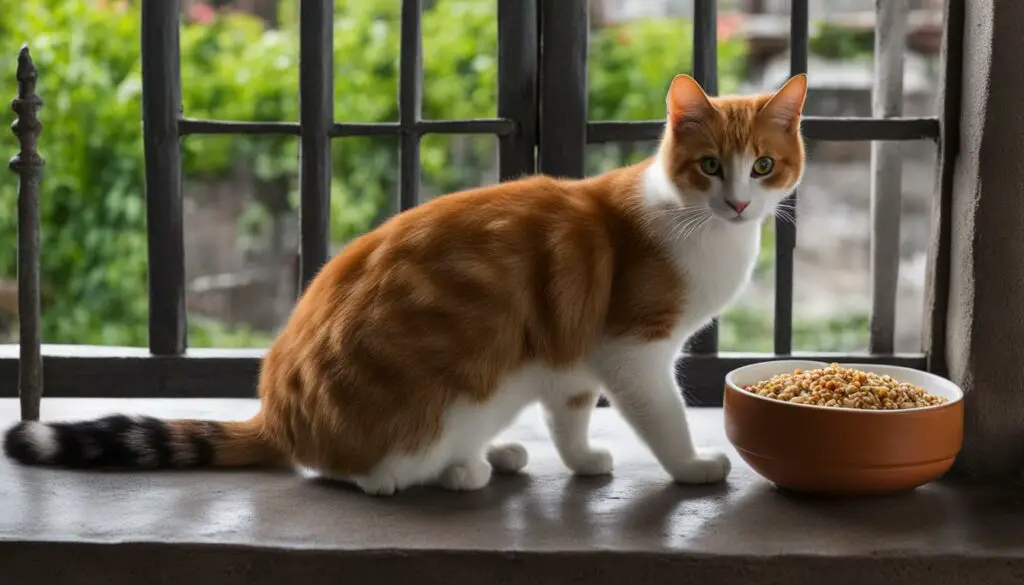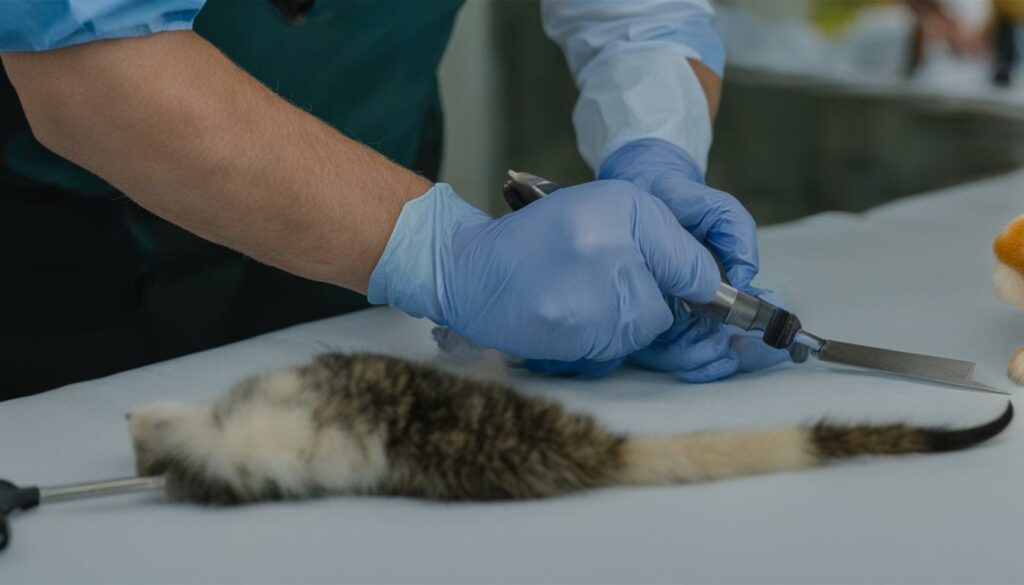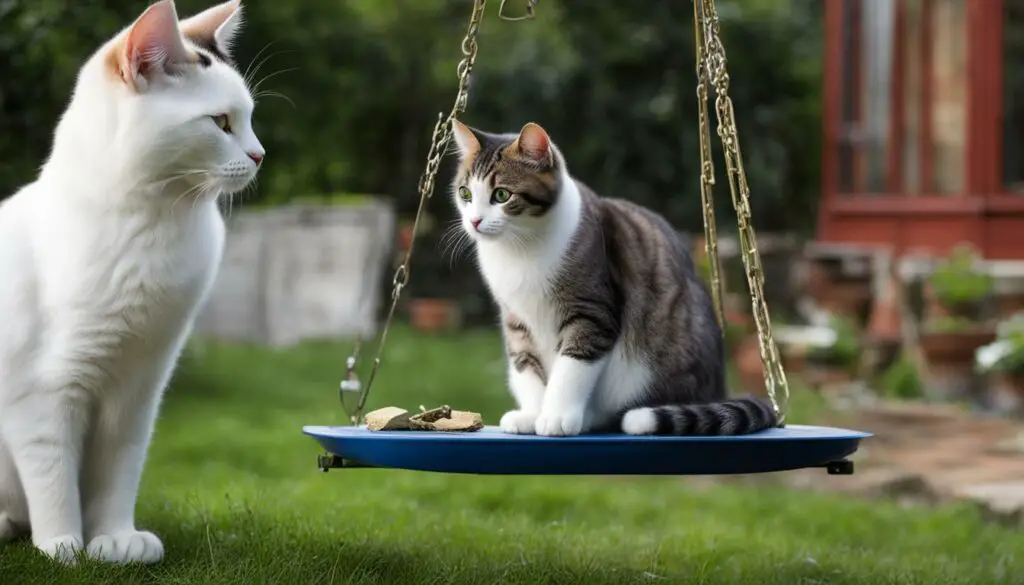The presence of a stray cat in my house has been both intriguing and challenging. In this article, I will explore the reasons behind why a stray cat keeps coming to my house and provide insightful perspectives on how to respond effectively. Understanding the behavior of stray cats and their impact on the neighborhood is crucial for finding the best solution.
Key Takeaways:
- Stray cats often exhibit challenging behaviors such as aggression and territory marking.
- Understanding the reasons behind a stray cat’s presence, such as seeking shelter or companionship, can help approach the situation with empathy.
- The presence of stray cats can have both positive and negative impacts on the neighborhood.
- Approaches to dealing with a stray cat include adoption and working with local intervention programs or shelters.
- Building trust and establishing boundaries are essential when dealing with a stray cat in your house.
The Behavior of Stray Cats
Stray cats can display various behaviors that contribute to the challenges of dealing with them. One common behavior is aggression, which can be directed towards other cats or pets in your household. This aggression may stem from the cat’s territorial instincts or past experiences. Another behavior is marking their territory through urine spraying or scratching furniture, which can be frustrating for homeowners. Additionally, some stray cats may exhibit food aggression, becoming possessive and defensive over their food sources.
Understanding these behaviors is crucial for developing effective strategies to manage the stray cat problem in your neighborhood. By recognizing the reasons behind these behaviors, such as resource scarcity or fear, it becomes possible to address them with empathy and find appropriate interventions. Stray cat behavior is often a result of their challenging circumstances, and by providing them with safe alternatives and opportunities for socialization, we can help improve their well-being and reduce the impact on the community.
Stray cats often exhibit certain behaviors that can be challenging to deal with. Understanding these behaviors can help in developing strategies to manage and address the stray cat problem in your neighborhood.
Preventing the growth of the stray population requires a comprehensive approach that includes spaying and neutering programs, as well as community education on responsible pet ownership. By addressing the underlying behaviors and providing support and resources, we can create a more harmonious environment for both stray cats and the community. It is important to remember that the behavior of stray cats is not inherently malicious but rather a response to their circumstances. With patience, understanding, and appropriate interventions, we can work towards finding sustainable solutions for the stray cat problem.
The Behavior of Stray Cats Table
| Behavior | Description |
|---|---|
| Aggression | Stray cats may display aggression towards other cats or pets, stemming from territorial instincts or past experiences. |
| Territory Marking | Stray cats may mark their territory by spraying urine or scratching furniture, asserting their presence. |
| Food Aggression | Some stray cats may exhibit food aggression, becoming possessive and defensive over their food sources. |
Understanding these behaviors can help in developing effective strategies to manage and address the stray cat problem in your neighborhood. By recognizing the reasons behind these behaviors, such as resource scarcity or fear, it becomes possible to address them with empathy and find appropriate interventions. Stray cat behavior is often a result of their challenging circumstances, and by providing them with safe alternatives and opportunities for socialization, we can help improve their well-being and reduce the impact on the community.

Preventing the growth of the stray population requires a comprehensive approach that includes spaying and neutering programs, as well as community education on responsible pet ownership. By addressing the underlying behaviors and providing support and resources, we can create a more harmonious environment for both stray cats and the community. It is important to remember that the behavior of stray cats is not inherently malicious but rather a response to their circumstances. With patience, understanding, and appropriate interventions, we can work towards finding sustainable solutions for the stray cat problem.
Reasons Behind a Stray Cat’s Presence
When a stray cat keeps coming to your house, there can be various reasons behind its presence. Understanding these underlying factors can help you approach the situation with empathy and compassion, while also considering the well-being of the cat and the community.
One reason for a stray cat’s presence could be that it is a homeless cat seeking shelter. Your house may provide a safe space for the cat to find refuge from the harsh elements or other dangers in the environment. Additionally, the cat may be looking for a source of food and water, especially if it has been struggling to find steady nourishment elsewhere.
Another reason for a stray cat’s regular visits could be the need for companionship. Cats are social animals, and they may seek human interaction and connection. Your house may have provided a positive experience or affection in the past, leading the cat to return for the sense of companionship it finds there.
Additionally, feral cats may view your house as a reliable source of feeding and caring. If the cat has been receiving food or attention from you or your neighbors, it may have developed a routine and formed a habit of returning to your house for sustenance and care.
| Reasons Behind a Stray Cat’s Presence | Key Factors |
|---|---|
| Homeless Cat Seeking Shelter | Protection from elements and dangers |
| Need for Companionship | Seeking social interaction with humans |
| Feral Cat Seeking Feeding and Care | Routine developed from receiving food and attention |
“Understanding the reasons behind a stray cat’s presence can help us approach the situation with empathy and compassion.”
Impact on the Neighborhood
When a stray cat keeps coming to your house, it not only affects you and your household but also has an impact on the entire neighborhood. The presence of stray cats can create both positive and negative consequences, which need to be carefully considered.
From an environmental perspective, the stray cat population can have detrimental effects. Stray cats may hunt and disturb local wildlife, potentially disrupting the natural balance of the ecosystem. This can be particularly concerning in areas with sensitive habitats or endangered species. Stray cats may also contribute to the spread of diseases among other animals, posing a risk to the overall animal welfare in the neighborhood.
However, it’s important to note that the presence of stray cats can also foster a sense of community and compassion. Many people find comfort and companionship in caring for and interacting with stray cats, creating a stronger bond among neighbors. These interactions can promote empathy and responsible cat ownership, leading to a more harmonious neighborhood environment.
The Impact on Stray Management
Effectively managing stray cats in the neighborhood is a shared responsibility. It requires collaboration between residents, local authorities, and animal welfare organizations. By addressing the stray cat problem collectively, the community can work towards finding humane solutions that serve the best interests of both the cats and the neighborhood.
Implementing robust stray management programs can help control the stray cat population and reduce the environmental impact. This can involve initiatives such as spaying and neutering stray cats to prevent further breeding, promoting responsible pet ownership to reduce the number of abandoned cats, and providing resources for community members to safely and humanely handle stray cats.
By prioritizing the well-being of stray cats and the overall welfare of the neighborhood, communities can strike a balance that supports both the human-animal bond and the preservation of the local environment.

Approaches to Dealing with a Stray Cat
When faced with a stray cat regularly coming to my house, I have explored several approaches to address the situation. One option that I considered was adoption, giving the cat a forever home where it could feel safe and loved. Additionally, I reached out to local stray intervention programs and shelters to ensure the cat’s welfare and protection.
Working with these organizations allowed me to collaborate with experienced professionals who could provide the necessary care and support for the stray cat. They offered valuable guidance on providing food, veterinary care, and shelter for the cat while seeking a suitable placement or adoption opportunity.
It is essential to consider the available resources and personal circumstances when deciding the best approach to dealing with a stray cat. Every situation is unique, and what works for one person may not work for another. By carefully evaluating the options and considering the well-being of both the cat and the community, it becomes possible to find a solution that benefits everyone involved.

Table: Comparison of Approaches to Dealing with a Stray Cat
| Approach | Description | Benefits |
|---|---|---|
| Adoption | Taking the cat into your home as a permanent member of the family. | Provides a stable and loving environment for the cat while ensuring its well-being. |
| Stray Intervention Programs | Collaborating with local organizations that specialize in stray cat management. | Offers access to professional guidance on providing care and finding suitable placement opportunities. |
| Shelter Placement | Entrusting the cat’s care to a reputable animal shelter or rescue organization. | Ensures the cat receives proper medical attention, socialization, and the chance to find a forever home. |
| Foster Care | Temporarily providing care for the cat until a permanent solution is found. | Gives the cat a safe and nurturing environment while waiting for adoption or placement. |
Approaches to Dealing with a Stray Cat
When faced with a stray cat regularly coming to my house, I have explored several approaches to address the situation. One option that I considered was adoption, giving the cat a forever home where it could feel safe and loved. Additionally, I reached out to local stray intervention programs and shelters to ensure the cat’s welfare and protection.
Working with these organizations allowed me to collaborate with experienced professionals who could provide the necessary care and support for the stray cat. They offered valuable guidance on providing food, veterinary care, and shelter for the cat while seeking a suitable placement or adoption opportunity.
It is essential to consider the available resources and personal circumstances when deciding the best approach to dealing with a stray cat. Every situation is unique, and what works for one person may not work for another. By carefully evaluating the options and considering the well-being of both the cat and the community, it becomes possible to find a solution that benefits everyone involved.
Building Trust and Establishing Boundaries
When dealing with a stray cat that keeps coming to your house, building trust and establishing boundaries is crucial. By providing consistent care and attention, you can create a safe and secure environment for the cat while also ensuring a harmonious relationship with your household.
Feeding the stray cat regularly is a vital step in building trust. By consistently providing food and water at the same time and place, you establish a routine that the cat can rely on. This helps the cat feel safe and secure, knowing that it will have access to sustenance.
However, it is important to set clear boundaries. Stray cats are often accustomed to fending for themselves and may exhibit certain behaviors that can be challenging, such as marking territory or becoming overly dependent. To prevent these issues, it is important to communicate your boundaries through body language and behavior.
Remember, building trust with a stray cat takes time and patience. Respect the cat’s space and avoid overwhelming it with too much attention. Allow the cat to come to you on its terms, and gradually introduce other members of your household to ensure a smooth transition.
Table: Establishing Trust and Boundaries with a Stray Cat
| Actions | Benefits |
|---|---|
| Regular feeding at the same time and place | Builds trust and establishes a routine |
| Respect the cat’s space | Allows the cat to feel safe and secure |
| Gradual introduction to household members | Ensures a smooth transition and minimizes stress |
| Set clear boundaries through body language and behavior | Establishes a mutual understanding of expectations |
Remember, building trust with a stray cat takes time and patience. Respect the cat’s space and avoid overwhelming it with too much attention. Allow the cat to come to you on its terms, and gradually introduce other members of your household to ensure a smooth transition.

By balancing compassion and the need to establish boundaries, you can create a positive and nurturing environment for both the stray cat and your household. With time, trust can be built, and a mutually beneficial relationship can be formed.
Seeking Professional Assistance
When dealing with a stray cat that exhibits challenging behavior, seeking professional assistance can be a wise decision. Veterinary care, behaviorists, and experts in stray cat management can provide valuable guidance in understanding and addressing the issues at hand. It is essential to prioritize the safety and well-being of both the cat and the individuals in your household.
Professional assistance can help in identifying the underlying causes of aggression or other problematic behaviors exhibited by the stray cat. Through socialization techniques and behavior modification strategies, experts can work towards improving the cat’s behavior and helping them adjust to a domestic environment. Additionally, they can offer advice on proper feeding, grooming, and overall care to ensure the cat’s physical and mental well-being.

If the stray cat shows signs of illness or injury, veterinary care is essential. A professional veterinarian can conduct a thorough examination, provide necessary vaccinations, and address any medical issues that may be contributing to the cat’s disruptive behavior. They can also offer advice on spaying or neutering to prevent unwanted litters and reduce territorial aggression.
Quotes:
“Seeking professional assistance is crucial when dealing with a stray cat’s problematic behavior. Veterinarians and behaviorists can provide the necessary expertise and guidance to ensure the safety and well-being of both the cat and your household.” – Dr. Emily Thompson, Animal Behavior Specialist
“Don’t hesitate to reach out to professionals when you’re facing difficulties with a stray cat. They can help you understand the root cause of the behavior and provide effective strategies for managing and resolving the issue.” – Sarah Johnson, Feline Behavior Consultant
Remember, seeking professional assistance is not a sign of failure but a proactive step towards finding a solution that benefits everyone involved. By working with experts in stray cat behavior, aggression, and socialization, you can improve the cat’s quality of life and create a harmonious environment in your home.
Engaging the Community
Addressing the stray cat problem requires a collective effort from the community. Engaging with neighbors, local animal welfare organizations, or community groups can help raise awareness about the issue and explore collaborative solutions. By working together, we can tackle the challenges posed by the stray cat population and ensure the well-being of both the cats and our neighborhoods.
“Coming together is a beginning; keeping together is progress; working together is success.” – Henry Ford
One way to engage the community is by organizing neighborhood meetings or events to discuss the stray cat problem. These gatherings provide an opportunity to share experiences, exchange knowledge, and brainstorm practical solutions. By involving community members in the decision-making process, we can foster a sense of ownership and collective responsibility for managing the stray population.
- Educational workshops or seminars can also be organized to educate community members about responsible pet ownership, the importance of spaying and neutering, and the benefits of adopting stray cats.
- Creating a local network or online forum dedicated to discussing stray cat issues can provide a platform for sharing information, seeking advice, and coordinating efforts.
- Collaborating with local animal welfare organizations or rescue groups can provide additional resources, support, and expertise.
Engaging the community is not only about finding practical solutions but also addressing compassion fatigue. Compassion fatigue can occur when individuals become overwhelmed or emotionally exhausted from caring for stray cats without seeing significant progress. By creating a support system within the community, we can alleviate the burden and share the responsibilities of managing the stray cat problem.

| Benefits of Engaging the Community | Ways to Engage the Community |
|---|---|
|
|
Understanding the Human-Animal Bond
When a stray cat finds its way into my house, it creates a unique opportunity to experience the profound human-animal bond. The presence of these furry creatures brings companionship, friendship, and a sense of connection that is difficult to replicate elsewhere. The unconditional love and loyalty they exhibit can have a profound impact on our lives.
Companionship with animals, such as stray cats, goes beyond mere ownership. It entails building a deep and empathetic relationship based on mutual trust and understanding. These cats rely on us for food, shelter, and care, and in return, they offer us their companionship and affection.
Friendship with a stray cat can be incredibly rewarding. These feline friends become a source of comfort, companionship, and entertainment. They provide a listening ear, offering solace during our moments of joy and sadness. The bond we share with these cats is unique, as it transcends language barriers and cultural differences.

Through the human-animal bond, we learn valuable lessons in empathy and compassion. Caring for a stray cat teaches us to consider the needs and well-being of others. It reminds us to be patient, understanding, and kind to animals and those around us. This bond fosters a sense of responsibility towards the welfare of animals, encouraging responsible pet ownership and promoting animal welfare initiatives in our communities.
Stray Cats and Conservation Efforts
The presence of stray cats in our neighborhoods can evoke a sense of compassion and care. However, it is important to consider their impact on the environment and conservation efforts. Stray cats, particularly in sensitive ecosystems, can pose a threat to native wildlife and biodiversity. Striking a balance between our compassion towards stray cats and the need to protect the local environment is crucial for maintaining ecological equilibrium.

When stray cats are introduced into an ecosystem where they don’t belong, they can disrupt the natural balance of native species. They may hunt and prey on small mammals, birds, and reptiles, leading to a decline in their population. This makes them an invasive species that can have a negative impact on the delicate biodiversity of an area.
To address this issue, it is important to raise awareness about the potential consequences of feeding or harboring stray cats in sensitive habitats. Implementing effective stray management programs that involve spaying and neutering can help control the stray population, reducing their impact on the environment. Additionally, promoting responsible pet ownership and advocating for cat owners to keep their pets indoors can also contribute to conservation efforts.
By considering the broader implications of stray cats on our ecosystem, we can make informed decisions that protect both the welfare of the cats and the biodiversity of our surroundings. It is our responsibility to find sustainable solutions that prioritize the conservation of our natural environment while still showing compassion towards stray cats.
Promoting Responsible Pet Ownership
When it comes to dealing with stray cats, promoting responsible pet ownership is key to addressing the stray cat management problem effectively. Responsible pet ownership involves several important aspects such as spaying and neutering, proper identification, and providing necessary care and support to ensure the well-being of both the cat and the community.
Spaying and Neutering
One of the most crucial steps in responsible pet ownership is spaying and neutering. This helps prevent unplanned litters, reduces the strain on already overflowing animal shelters, and contributes to the overall health and well-being of cats. Spaying and neutering also help reduce certain behavioral problems in cats, such as aggression and roaming.
Proper Identification
Ensuring that your cat has proper identification is essential in case they go missing. Microchipping is a reliable and permanent form of identification that can help reunite lost cats with their owners. ID tags with contact information can also be used as an additional means of identification. Proper identification reduces the chances of cats becoming stray or feral and increases the likelihood of a successful reunion if they do get lost.
Providing Care and Support
Responsible pet ownership involves providing adequate care and support for your cat. This includes providing a balanced diet, regular veterinary check-ups, and keeping up with vaccinations and preventive treatments. Additionally, providing a safe and stimulating environment, including toys and scratching posts, helps keep cats mentally and physically healthy.
By promoting responsible pet ownership, we can not only reduce the stray cat population but also create a more compassionate and caring community. Spaying and neutering, proper identification, and providing care and support are all important steps in ensuring the well-being of both cats and the neighborhoods they inhabit.

Balancing Compassion and Practicality

When dealing with a stray cat problem, it is important to find a balance between compassion and practicality. While it is natural to feel empathy towards stray cats and want to help them, it is essential to consider the wider implications and find practical solutions that benefit both the cats and the community. This can involve exploring options for adoption, working with local stray management programs, or supporting initiatives that promote responsible pet ownership.
Adoption is a compassionate solution that provides a permanent home for a stray cat. By adopting a stray, you not only offer them a safe and loving environment but also help reduce the stray population. It is important to consider your personal circumstances and resources before deciding to adopt, as it requires a long-term commitment.
In addition to adoption, working with local stray management programs can make a significant impact. These programs often focus on spaying and neutering stray cats to prevent further reproduction and control the stray population. Supporting such initiatives can help address the root cause of the stray cat problem and ensure a more sustainable solution.
| Approach | Pros | Cons |
|---|---|---|
| Adoption | – Provides a permanent home for a stray cat – Reduces the stray population |
– Requires a long-term commitment – Personal circumstances and resources need to be considered |
| Working with stray management programs | – Addresses the root cause of the stray cat problem – Helps control the stray population |
– Relies on the efforts of the community – Requires coordination and support |
By finding the balance between compassion and practicality, we can work towards creating a harmonious environment that benefits both stray cats and the community. Through adoption and supporting local stray management programs, we can make a positive difference in addressing the stray cat problem and promoting responsible pet ownership.
Support and Resources
Dealing with a stray cat can be a challenging situation, but you don’t have to face it alone. There are various support and resources available to help you navigate this journey and find the best solutions for both the cat and your community.
One valuable resource is local animal welfare organizations. These organizations specialize in assisting with stray cat issues and can provide guidance on responsible stray cat management, trap-neuter-return programs, and adoption options. They can connect you with experienced professionals who can offer expert advice tailored to your specific situation.
Remember, asking for help is not a sign of weakness but a step towards finding the most effective and compassionate solutions.
Online forums and support groups can also be great sources of support and information. Connecting with others who have faced similar situations can offer valuable insights and emotional support. These communities often share tips, success stories, and resources that can guide you in your journey of dealing with a stray cat.
Additionally, it’s important to reach out to your local community. Engaging with neighbors and community groups can raise awareness about the stray cat problem and potentially lead to collaborative solutions. By working together, you can pool resources, share experiences, and support each other in finding the best course of action.
Support and Resources:
| Resource | Description |
|---|---|
| Local Animal Welfare Organizations | Specialized support for stray cat management and guidance on adoption and trap-neuter-return programs. |
| Online Forums and Support Groups | Connect with others facing similar situations, share experiences, and gain valuable insights and emotional support. |
| Community Groups | Engage with neighbors and local community organizations to raise awareness and find collaborative solutions. |
Remember, dealing with a stray cat requires patience, empathy, and a collective effort. The support and resources available to you can make this journey more manageable and ultimately lead to the best outcomes for both you and the stray cat.

Conclusion
Dealing with a stray cat that keeps coming to my house requires an effective response rooted in understanding and empathy. By exploring the reasons behind the cat’s presence, engaging the community, and seeking professional assistance when needed, I can find the best solution to this ongoing situation.
Understanding the behavior of stray cats and their impact on the neighborhood is crucial for finding a balanced approach. By considering the welfare of both the cat and the community, I can create a harmonious environment that balances compassion and practicality in managing the stray cat problem.
It is important to remember that building trust and establishing boundaries, as well as considering the larger issue of stray population and the need for effective intervention, are key elements of finding a long-term solution. By promoting responsible pet ownership and engaging with local animal welfare organizations, I can contribute to the overall well-being of both the stray cats and the community.
In conclusion, addressing the presence of a stray cat in my house requires a multi-faceted approach that combines understanding, empathy, and responsible pet ownership. By taking these steps, I can find an effective response that not only benefits the stray cat but also ensures a harmonious coexistence within the neighborhood.
FAQ
Why does a stray cat keep coming to my house?
There can be various reasons, such as seeking shelter, food, or companionship.
What are the behaviors of stray cats that can be challenging?
Stray cats may display aggression, mark their territory, or be food aggressive.
How can I address the stray cat problem in my neighborhood?
It is crucial to understand the behavior of stray cats and work with local stray management programs or shelters.
What are the positive and negative impacts of stray cats in a neighborhood?
Some appreciate the companionship, while others are concerned about the effects on the environment and animal welfare.
What approaches can I take to deal with a stray cat regularly coming to my house?
You can explore adoption or work with local intervention programs to ensure the cat’s welfare.
How can I build trust with a stray cat and establish boundaries?
Providing regular food, water, and shelter can help establish security, while setting clear boundaries is crucial.
When should I seek professional assistance for a stray cat?
If the cat’s behavior becomes unmanageable or poses a threat, it may be necessary to consult animal behaviorists or veterinarians.
How can I engage the community in addressing the stray cat problem?
Engaging with neighbors and local animal welfare organizations can help raise awareness and find collaborative solutions.
What is the significance of the human-animal bond?
The bond offers companionship, friendship, and a sense of connection, promoting responsible pet ownership and animal welfare.
What should I consider about stray cats and conservation efforts?
Stray cats, especially in sensitive ecosystems, can pose a threat to native wildlife, necessitating a balance between compassion and protection.
How can I promote responsible pet ownership in managing the stray cat population?
Spaying and neutering cats and ensuring identification can prevent unplanned litters and help reunite lost cats with owners.
How can I find support and resources for dealing with a stray cat?
Local animal welfare organizations, online forums, and support groups can provide valuable advice and guidance.
How can I balance compassion and practicality when dealing with a stray cat?
It is crucial to consider both the cat and the community’s welfare, exploring options like adoption and supporting responsible pet ownership.








